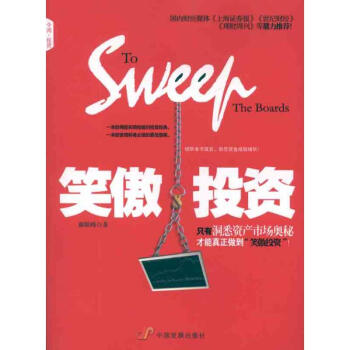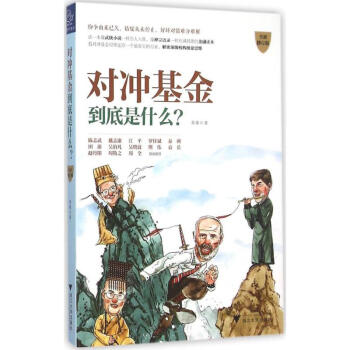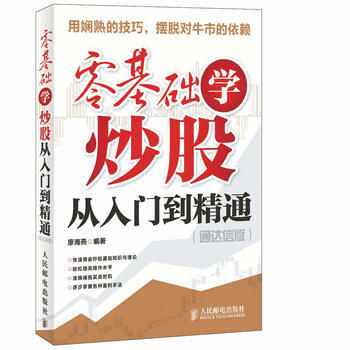![利率衍生物定价的有效方法 [Efficient Methods for Valuing Interest Rate Derivatives(Springer Finance)]](https://pic.windowsfront.com/11314933/rBEhWFIxh_8IAAAAAADHdB1rBccAADFiQApqAcAAMeM466.jpg)

具体描述
内容简介
《利率衍生物定价的有效方法》是一部全面讲述计算和管理利率衍生物模型的教程。分为两个部分:第一部分比较和讨论了传统模型,比如即期和远期利率模型;第二部分主要讲述新发展起来的市场模型。《利率衍生物定价的有效方法》和同时期众多图书的不同之处在于,不仅专注于数学知识,并大量刻画了作者在工业应用中的实践经验。目录
1. introduction2. arbitrage, martingales and numerical methods
2.1 arbitrage and martingales
2.1.1 basic setup
2.1.2 equivalent martingale measure
2.1.3 change of numeraire theorem
2.1.4 girsanov's theorem and ito's lemma
2.1.5 application: black-scholes model
2.1.6 application: foreign-exchange options
2.2 numerical methods
2.2.1 derivation of black-scholes partial differential equation
2.2.2 feynman-kac formula
2.2.3 numerical solution of pde's
2.2.4 monte carlo simulation
2.2.5 numerical integration
part i. spot and forward rate models
3. spot and forward rate models
3.1 vasicek methodology
3.1.1 spot interest rate
3.1.2 partial differential equation
3.1.3 calculating prices
3.1.4 example: ho-lee model
3.2 heath-jarrow-morton methodology
3.2.1 forward rates
3.2.2 equivalent martingale measure
3.2.3 calculating prices
3.2.4 example: ho-lee model
3.3 equivalence of the methodologies
4. fundamental solutions and the forward-risk-adjusted measure
4.1 forward-risk-adjusted measure
4.2 fundamental solutions
4.3 obtaining fundamental solutions
4.4 example: ho-lee model
4.4.1 radon-nikodym derivative
4.4.2 fundamental solutions
4.5 fundamental solutions for normal models
5. the hull-white model
5.1 spot rate process
5.1.1 partial differential equation
5.1.2 transformation of variables
5.2 analytical formulae
5.2.1 fundamental solutions
5.2.2 option prices
5.2.3 prices for other instruments
5.3 implementation of the model
5.3.1 fitting the model to the initial term-structure
5.3.2 transformation of variables
5.3.3 trinomial tree
5.4 performance of the algorithm
5.5 appendix
6. the squared gaussian model
6.1 spot rate process
6.1.1 partial differential equation
6.2 analytical formulee
6.2.1 fundamental solutions
6.2.2 option prices
6.3 implementation of the model
6.3.1 fitting the model to the initial term-structure
6.3.2 trinomial tree
6.4 appendix a
6.5 appendix b
7. an empirical comparison of one-factor models
7.1 yield-curve models
7.2 econometric approach
7.3 data
7.4 empirical results
7.5 conclusions
part ii. market rate models
8. libor and swap market models
8.1 libor market models
8.1.1 libor process
8.1.2 caplet price
8.1.3 terminal measure
8.2 swap market models
8.2.1 interest rate swaps
8.2.2 swaption price
8.2.3 terminal measure
8.2.4 ti-forward measure
8.3 monte carlo simulation for libor market models
8.3.1 calculating the numeraire rebased payoff
8.3.2 example: vanilla cap
8.3.3 discrete barrier caps/floors
8.3.4 discrete barrier digital caps/floors
8.3.5 payment stream
8.3.6 ratchets
8.4 monte carlo simulation for swap market models
8.4.1 terminal measure
8.4.2 ti-forward measure
8.4.3 example: spread option
9. markov-functional models
9.1 basic assumptions
9.2 libor markov-functional model
9.3 swap markov-functional model
9.4 numerical implementation
9.4.1 numerical integration
9.4.2 non-parametric implementation
9.4.3 semi-parametric implementation
9.5 forward volatilities and auto-correlation
9.5.1 mean-reversion and auto-correlation
9.5.2 auto-correlation and the volatility function
9.6 libor example: barrier caps
9.6.1 numerical calculation
9.6.2 comparison with libor market model
9.6.3 impact of mean-reversion
9.7 libor example: chooser- and auto-caps
9.7.1 auto-caps/floors
9.7.2 chooser-caps/floors
9.7.3 auto- and chooser-digitals
9.7.4 numerical implementation
9.8 swap example: bermudan swaptions
9.8.1 early notification
9.8.2 comparison between models
10. an empirical comparison of market models
10.1 data description
10.2 libor market model
10.2.1 calibration methodology
10.2.2 estimation and pricing results
10.3 swap market model
10.3.1 calibration methodology
10.3.2 estimation and pricing results
10.4 conclusion
11. convexity correction
11.1 convexity correction and change of numeraire
11.1.1 multi-currency change of numeraire theorem
11.1.2 convexity correction
11.2 options on convexity corrected rates
11.2.1 option price formula
11.2.2 digital price formula
11.3 single index products
11.3.1 libor in arrears
11.3.2 constant maturity swap
11.3.3 diffed libor
11.3.4 diffed cms
11.4 multi-index products
11.4.1 rate based spread options
11.4.2 spread digital
11.4.3 other multi-index products
11.4.4 comparison with market models
11.5 a warning on convexity correction
11.6 appendix: linear swap rate model
12. extensions and further developments
12.1 general philosophy
12.2 multi-factor models
12.3 volatility skews
references
index
前言/序言
用户评价
我最近翻阅了《利率衍生物定价的有效方法》这本书,虽然我还没有完全深入到每一个公式的推导细节中,但仅从其整体架构和所涉及的主题来看,就能感受到作者在这一领域投入了相当大的心血。这本书的标题本身就非常吸引人——“有效方法”,这暗示着它不仅仅是对现有理论的复述,更侧重于提供一种优化、提速或更精确的解决方案。我个人长期以来在金融建模领域摸索,对于衍生品定价,特别是利率衍生品,总觉得有许多可以挖掘和改进的空间。市场上的利率波动一直是金融机构面临的核心风险之一,而如何准确地衡量和定价这些风险,是业务能否稳健发展的关键。我非常关注书中是否会深入探讨不同利率模型(例如,LMM, HJM, CIR, Hull-White等)的优缺点,以及它们在不同市场环境下(如零利率、负利率、高波动率)的适应性。对于“有效方法”的解读,我最看重的是其在实际应用中的可行性和效率。书中会不会介绍一些能够显著缩短计算时间的算法,或者是一些能够更精确捕捉市场微观结构的模型?我非常好奇作者是如何定义和实现“有效”的,是通过更优的数值方法,如更快的蒙特卡洛路径生成技术,更精准的离散化方法,还是通过一些创新的解析近似方法?我特别期待书中能够对复杂利率衍生品,例如CMS Spread Options, Bermudan Swaptions, Floor/Caplets with stochastic volatility等,提供清晰的定价框架和实现指南。此外,如果书中能够包含一些关于模型校准(Calibration)的深入讨论,以及如何处理模型风险(Model Risk),那将对我的工作有巨大的帮助。毕竟,模型的准确性很大程度上取决于其参数是否能恰当地反映市场状况。这本书的 Springer Finance 系列标签,也让我对其理论严谨性有了很高的信心,我相信它一定包含了扎实的数学基础和严谨的推导过程。我希望在阅读过程中,能够不断地获得启发,找到解决我在工作中遇到的实际定价难题的“灵感火花”,甚至能够指导我开发出属于自己的更具竞争力的定价模型。
评分当我第一次看到《利率衍生物定价的有效方法》这本书时,我的目光就被深深吸引了。作为一名长期从事金融量化工作的从业者,我深知在瞬息万变的金融市场中,对利率衍生品进行精准且高效的定价,是风险管理和投资决策的关键。这本书的标题“有效方法”恰恰点出了我一直以来所追求的目标。我非常好奇,作者是如何定义和实现“有效”的。它是否涉及到更快的数值计算算法,例如优化的蒙特卡洛模拟技术、更精密的有限差分法,或者是一些前沿的格点方法?又或者,“有效”体现在模型本身的鲁棒性上,能够更好地应对市场波动和参数不确定性?我特别关注书中是否会提供一些能够应对当前低利率,甚至负利率环境下,传统利率模型失效的解决方案。这些非典型市场条件对现有的定价框架提出了严峻的考验,我希望能在这本书中找到解决这些难题的线索。此外,对于一些结构极其复杂的利率衍生品,如那些具有路径依赖性、多重行权特征或涉及复杂的风险因子对冲的产品,其定价难度往往呈指数级增长。我非常期待书中能够提供一些在计算上更为高效,同时又能保持较高精度的定价技术,例如一些先进的数值算法或解析近似方法。Springer Finance的出版背景,让我对其内容的学术严谨性和前沿性有了极高的信心。我希望这本书能够为我带来一些我之前未曾接触过的,但极具实际应用价值的定价理论和技术,帮助我更好地理解市场动态,更有效地管理和定价利率风险。这本书对我来说,不仅仅是一次知识的补充,更是一次提升实战能力的绝佳机会,我希望能从中获得能够真正改变我工作方式的“有效方法”。
评分当我看到《利率衍生物定价的有效方法》这本书的标题时,我的内心涌起一股强烈的共鸣,因为这正是我在日常工作中一直在追寻的目标。作为一名量化分析师,我对金融衍生品的定价原理和计算效率有着近乎苛刻的要求。特别是利率衍生品,其定价模型往往涉及复杂的随机微分方程和高维积分,如何找到既能保证精度又能在计算上高效的“有效方法”,一直是困扰着我的难题。我非常期待这本书能够提供一些突破性的见解。例如,书中是否会介绍一些最新的蒙特卡洛模拟技术,如低差异序列(low-discrepancy sequences)的应用,或者一些能够显著加速模型校准过程的算法?我尤其关注书中是否会针对当前流行的利率模型,如Libor Market Model (LMM) 或 Heath-Jarrow-Morton (HJM) 模型,提出一些新的定价算法,使其在计算速度和鲁棒性方面得到显著提升。此外,对于那些非线性的、带有早期行权特征的利率衍生品,如百慕大式掉期期权(Bermudan Swaptions),其定价难度更是呈指数级增长。我迫切希望书中能够提供一些高效的数值方法,如先进的有限差分法或最小二乘蒙特卡洛法,来解决这些挑战。Springer Finance的标签让我对其内容的专业性和学术严谨性充满了信心,我相信这本书一定蕴含着丰富的理论知识和实用的技术。我希望能通过这本书,不仅能够深化我对利率衍生品定价理论的理解,更能掌握一些切实可行的、能够直接应用于我日常工作的“有效方法”,从而在工作中取得更大的突破。我期待着这本书能像一把钥匙,为我开启更高效、更精准的利率衍生品定价之门。
评分这本书的到来,就像给我的金融模型工具箱注入了一剂强心针。我一直深耕于利率衍生品领域,对于如何在复杂的市场环境中,以最快的速度和最高的精度来评估这些产品的价值,有着持续的探索欲望。这本书的标题《利率衍生物定价的有效方法》精准地击中了我的痛点。我非常好奇作者所提出的“有效方法”究竟体现在哪些方面。是计算效率的指数级提升?是对传统模型在极端市场条件下的根本性突破?还是对模型参数校准和敏感性分析的革新?我从事金融量化工作多年,深知一个模型从理论到实践,需要跨越多少障碍。我尤其关注书中是否会提供一些能够应对当前低利率环境,甚至负利率环境下的新型定价框架。以往的许多模型,在这些非传统市场条件下,往往会显得力不从心,甚至产生一些令人费解的结果。我非常期待书中能够就此提供一些切实可行的解决方案,比如对现有模型进行有效修正,或是提出全新的、能够更好地刻画市场动态的建模思路。此外,对于那些极为复杂的、带有路径依赖或多重期权的利率衍生品,其定价难度更是呈几何级增长。我迫切地希望这本书能提供一些在计算上更高效,同时在准确性上又能保持很高水平的定价技术,例如,对于那些难以解析求解的偏微分方程,是否有更优的数值离散化方案,或者是否有基于概率或统计方法的近似定价技术。这本书的 Springer Finance 出版社背景,也让我对其内容的深度和前沿性有了极高的期待。我希望能从中学习到一些最新的研究成果,并将其转化为我实际工作中的优势。我更希望它能帮助我理解,如何在“有效”与“精确”之间找到一个最佳的平衡点,以及如何根据不同的业务需求和市场特点,灵活地选择和应用最适合的定价方法。这本书,对我而言,不仅是理论知识的补充,更是一次提升实战能力的契机,我希望它能够引领我走向更高效、更精准的利率衍生品定价之路。
评分《利率衍生物定价的有效方法》这本书的封面,就如同一个信号,预示着我即将踏上一段深入探究利率衍生品定价奥秘的旅程。我一直深信,在金融工程领域,理论的优雅与实现的效率必须并驾齐驱。我对书中“有效方法”的解读充满好奇,它是否意味着在计算速度上的飞跃,能够让我更快地评估那些需要即时反应的市场机会?还是说,它能提供一种更优的数值算法,使得在精度不打折扣的前提下,显著降低计算资源的消耗?我尤其关注的是,在当前全球利率水平持续走低的特殊时期,许多传统的定价模型都面临着严峻的挑战,甚至出现了一些理论上的悖论。我非常期待本书能够就此提供一些前瞻性的见解,或者提出能够有效应对低利率和负利率环境的新型定价框架。此外,对于那些结构极其复杂的利率衍生品,例如涉及远期利率协议(FRA)链、利率互换期权(Swaption)组合,甚至是信用风险与利率风险耦合的产品,其定价难度更是呈几何级增长。我迫切希望书中能够提供一些能够简化计算过程,同时又不牺牲精度的定价技术,或许是某种巧妙的解析近似方法,又或者是更先进的机器学习算法在定价领域的应用。Springer Finance的出版标签,让我对其内容的学术严谨性和前沿性充满了信心,我相信这本书一定能为我带来一些高质量的学术成果和实用的技术指导。我希望通过这本书,不仅能够深化我对利率衍生品定价理论的理解,更重要的是,能够掌握一些能够直接应用于我日常工作中的“有效方法”,从而在瞬息万变的金融市场中,保持我的竞争优势。
评分当我拿到《利率衍生物定价的有效方法》这本书时,心中充满了期待,因为“有效方法”这个词汇,精准地触及了我作为一名金融工程师在日常工作中一直在追求的核心价值。我一直坚信,在复杂的金融衍生品定价领域,仅仅拥有理论知识是不够的,更重要的是能够将其转化为高效、准确的实践工具。我非常好奇,作者是如何对“有效”进行界定的,它是否意味着更快的计算速度,更低的计算成本,还是对市场极端情况的更强适应性?我目前最关心的是,在当前低利率甚至负利率的宏观经济环境下,许多传统的利率衍生品定价模型都显得力不从心。我非常期待书中能够提供一些能够应对这些非传统市场条件的创新模型或方法,或者至少提供一些切实可行的模型修正策略。此外,对于一些结构极为复杂的利率衍生品,例如那些涉及多重利率期限结构、路径依赖性或者复杂的对冲策略的产品,其定价往往是极具挑战性的。我希望这本书能够提供一些能够显著降低计算复杂度的定价技术,从而在满足业务需求的同时,也能保证结果的可靠性。Springer Finance的出版背景,让我对其内容的专业性和学术深度有着极高的期待,我相信书中一定蕴含着经过严格推导和验证的理论成果。我希望通过这本书的学习,能够获得一些我之前未曾了解过的、但极具实用价值的定价技术,从而能够在我面对复杂利率衍生品时,更加从容自信,并能为我的机构带来更优化的风险管理和投资决策。这本书,对我而言,是一份提升实战能力的宝贵财富,我期待它能为我打开一扇通往更高效、更精准定价领域的大门。
评分这本书的出现,对于我这样长期与利率衍生品打交道的人来说,简直是一场及时雨。《利率衍生物定价的有效方法》这个标题,就足以点燃我对书中内容的无限遐想。我一直深信,在金融工程领域,理论的创新与计算效率的提升是相辅相成的,缺一不可。我非常好奇,作者是如何定义并构建这些“有效方法”的。这是否意味着,书中会介绍一些能够绕过复杂解析求解,而采用更简洁、更快速的数值方法?比如,对于一些经典的利率模型,作者是否提供了比现有文献更优化的数值离散化方案,或者是通过更聪明的样本路径生成技术来提升蒙特卡洛模拟的收敛速度?我目前最关注的一个问题是,在当前全球低利率甚至负利率的环境下,许多传统的利率衍生品定价模型都面临着严峻的挑战。我非常期待书中能够就此提供一些创新的解决方案,或者至少提供一些切实可行的模型修正方法,以保证在这些非典型市场条件下的定价准确性。同时,对于一些结构非常复杂的利率衍生品,例如涉及多重利率期限结构,或者带有复杂的条件触发机制的产品,其定价往往需要消耗巨大的计算资源。我希望这本书能够提供一些能够显著降低计算复杂度的定价技术,从而在有限的时间内获得满意的结果。 Springer Finance 的出版背景,也让我对其内容的学术深度和前沿性有了很高的期待。我希望这本书不仅仅是一本理论书籍,更是一份能够指导我实际操作的宝贵手册,它能帮助我更好地理解市场,更精准地评估风险,并最终做出更明智的交易决策。我期待着,通过这本书的学习,能够将我的利率衍生品定价能力提升到一个全新的水平。
评分我一直关注着金融市场中利率衍生品定价的最新发展,而《利率衍生物定价的有效方法》这本书的出现,无疑为我打开了一扇新的窗户。作为一名长期在金融领域工作的专业人士,我深切体会到,在瞬息万变的金融市场中,及时、准确地对利率衍生品进行定价,是风险管理和投资决策的基石。这本书的标题“有效方法”立刻引起了我的兴趣,这并非简单的理论罗列,而是对提升定价效率和精度的承诺。我迫切地想知道,作者是如何定义和实现“有效”的。它是否涉及更快的数值计算算法,比如更优的蒙特卡洛模拟方法、更高效的有限差分法,或者是一些先进的格点方法?又或者,“有效”体现在模型本身的鲁棒性上,能够更好地应对市场波动和参数不确定性?我尤其关注书中是否会提供一些能够处理极端利率环境,例如负利率环境下的定价模型和方法。许多传统的利率模型在这些非典型市场条件下,往往会失效或者需要进行大量的调整,我希望能在这本书中找到解决这些难题的线索。此外,对于一些结构复杂的利率衍生品,如信用违约互换(CDS)相关的利率衍生品,或者涉及多种利率基准的产品,其定价往往是极具挑战性的。我希望这本书能够提供一些能够应对这些复杂情况的定价框架和技术。Springer Finance 的标签让我相信,这本书的内容一定是经过严格的学术审视,并且具有相当的深度和前沿性。我非常期待能够从中学习到一些尚未普及的、但极具实用价值的定价技术,并将其运用到我的实际工作中,以提升我对利率衍生品市场的理解和掌控能力。这本书在我看来,不仅仅是一本理论著作,更是一份能够帮助我在激烈的市场竞争中保持领先地位的宝贵指南。
评分收到《利率衍生物定价的有效方法》这本书,我感到一阵欣喜,因为这正是我在金融量化领域长期以来一直在探索的方向。在瞬息万变的金融市场中,对利率衍生品进行精准且高效的定价,是每一个风险管理和投资决策者必须面对的核心挑战。这本书的标题“有效方法”直接触及了我工作的痛点,我迫切地想知道作者是如何理解和实现“有效”的。是计算速度上的突破,还是模型精度的提升,又或者是对复杂场景的更强适应性?我尤其感兴趣的是,书中是否会提供一些能够应对当前低利率和负利率环境下,传统利率模型失效的解决方案。这些非传统市场条件对现有的定价框架提出了严峻的考验,我希望能在这本书中找到新的思路和方法。此外,对于一些极其复杂的利率衍生品,例如那些具有路径依赖性、多重行权特征或涉及复杂的风险因子对冲的产品,其定价难度往往呈指数级增长。我非常期待书中能够提供一些在计算上更为高效,同时又能保持较高精度的定价技术,比如一些先进的数值算法或解析近似方法。Springer Finance的出版背景,也让我对其内容的学术严谨性和前沿性有了极高的信心。我希望这本书能够为我带来一些我之前未曾接触过的,但极具实际应用价值的定价理论和技术,帮助我更好地理解市场动态,更有效地管理和定价利率风险。这本书对我来说,不仅仅是一次知识的补充,更是一次提升实战能力的绝佳机会,我希望能从中获得能够真正改变我工作方式的“有效方法”。
评分我最近入手了这本《利率衍生物定价的有效方法》,书名里“Springer Finance”的标签让我对内容的严谨性和深度抱有很高的期待,毕竟 springer出版社在学术出版界的影响力是毋庸置疑的。拿到书的第一感觉是它的厚重感,这通常预示着内容的扎实和理论的详尽,也暗示了它并非一本轻松易读的入门读物,更适合那些已经对金融工程或量化金融有所了解,并且希望深入研究利率衍生物定价模型的读者。我个人在工作中会接触到大量的金融衍生品,尤其是利率类产品,市场上的波动性常常让我想方设法去寻找更精准、更高效的定价工具。因此,当看到“有效方法”这个关键词时,我立刻被吸引了。我希望这本书能够提供一些我之前未曾涉猎过,但却能切实提升我定价能力和风险管理水平的新颖理论或算法。我尤其关注的是,书中对于“有效”的定义是什么,是计算速度上的提升,还是模型鲁棒性的增强,亦或是能处理更广泛的衍生品类型。我设想书中可能会涉及一些前沿的数值方法,比如蒙特卡洛模拟的改进技术,有限差分法的优化,或者是一些基于偏微分方程的解析解或半解析解的推导。同时,我也很期待书中能够对不同模型在不同市场环境下的适用性进行深入的比较和分析,毕竟金融市场瞬息万变,单一的模型很难做到“万能”。这本书的出版日期也是我考虑的一个因素,如果它足够新,那么它所涵盖的内容很可能更能反映当前的金融市场实践和理论前沿。我目前最大的困惑在于,在低利率甚至负利率环境下,许多传统的定价模型似乎失效或者需要进行大幅度的修正,这本书是否能够为这些挑战提供一些创新的解决方案,是我非常期待的部分。我也希望书中能够包含一些实际的案例研究,通过真实的数据和情景来展示这些有效方法的应用,这样不仅能加深理解,也能为实际操作提供宝贵的借鉴。总而言之,这本书在我眼中,不仅仅是一本理论书籍,更是一个解决实际业务问题的潜在工具箱,我迫不及待地想开始探索其中的奥秘,看看它是否能真正兑现“有效方法”的承诺,为我在利率衍生物定价领域带来新的视角和突破。
相关图书
本站所有内容均为互联网搜索引擎提供的公开搜索信息,本站不存储任何数据与内容,任何内容与数据均与本站无关,如有需要请联系相关搜索引擎包括但不限于百度,google,bing,sogou 等,本站所有链接都为正版商品购买链接。
© 2025 windowsfront.com All Rights Reserved. 静流书站 版权所有




















